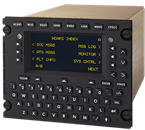

Modifications (105)
Introduction of ADS-B Out as per CS-ACNS


Automatic Dependent Surveillance-Broadcast (ADS-B) is a system broadcasting, without the need for action from the pilot or any request from ATC, that provides an enhanced set of aircraft surveillance data to Air Traffic Management (and potentially to other airplanes)
Activation Controller Pilot Data-Link Communications [CPDLC] capability


CPDLC (controller pilot data link communications) is a two-way data-link system by which controllers can transmit non-urgent strategic messages to an aircraft as an alternative to voice communications. The message is displayed on a flight deck visual display. The CPDLC application provides air-ground data communication for the ATC service.
Limitations:
- This CPDLC installation has to be used only during the cruise flight phase above FL 285.
- This CPDLC installation has to be used only for non-time critical messages.
Use of TRA-45A Display Indicator


The Honeywell TRA 45A combines terrain display and radio altitude information into a single, space-saving multifunction instrument. The TRA-45A is designed to work with Honeywell's enhanced ground proximity warning systems (EGPWS). It’s lightweight and small size conserves scarce instrument panel space. The display is a colour active-matrix liquid crystal display (AMLCD).
Removal of Divan Seating Restriction


Installation of an arrester block cushion onto the upper surface of the forward divan cabinet, which allows the removal of an existing restriction on the occupation of the forwardmost seating position on the side facing divan, The change also removes existing placards which limited the seat position as “Not to be occupied during Taxi. Take-off or Landing”.
Reduction of Over-Wing Emergency Exits


The removal (deactivation) of the left and right forward over wing emergency exits in a Boeing 757-200. In addition, a reduction of the passenger seating capacity limitation, in line with the removal of the emergency exits. This will permit an improved passenger seating configuration to be installed in the aircraft. This design change was due to the aircraft is utilised solely on low density passenger routes.
Introduction of Wireless Local Area Network.


An Airborne Wireless Local Area Network Unit (AWLU), comprising a CNX-200 Network
Accelerator and two S-band antennas provides, in conjunction with the satellite communication system, onboard data networking for computers and other electronic devices used by both passengers and crew. Access to the Local Area Network (LAN) is via wireless connection or four LAN ports located at the left-hand seat 2, right-hand seat 2, left-hand outboard seat 4, and left-hand seat 5.
Introduction of Wingspeed XLLink Communications and Data Management System


Introduction of Wingspeed XLLink Satcom Communications and Data Management System
Limitations: Prior to installation of this modification the installer must determine that the interrelationship between this modification and any other previously installed modification will introduce no adverse effect upon the airworthiness of the product.
Introduction of VHF Comm & Satcom Antennas


This design change introduces provisions to the crown skin of the Airbus A330 aircraft for the later fit of a SATCOM antenna (by separate design change).
Conditions: Prior to installation of this design change it must be determined that the interrelationship between this design change and any other previously installed design change and/ or repair will introduce no adverse effect upon the airworthiness of the product.
Introduction of Swift Broadband


Introduction of Aircell SwiftBroadband System (SBB) with an Aircell Cabin Telecommunications Router (CTR). This is an Inmarsat only system for both voice calls and high-speed data connections.
The system comprises of the following:
•A SwiftBroadband Unit (SBU), which will replace the existing Satellite Communication Unit.
•A High-Power Amplifier/Low Noise Amplifier/Diplexer (HLD), which will replace the
High Power Amplifier/Low Noise Amplifier (HPA/LNA).
•An Intermediate Gain Antenna, which will replace the existing Satcom Antenna Note: The Satellite Communication Unit, HPA/LNA and Satcom Antenna form part of the AFIS Satcom System, which is to be removed.
•An Aircell Cabin Telecommunications Router (CTR) interfaced with the Aircell
SwiftBroadband System (SSB) via an Ethernet cable.
Introduction of SSR Mode S Enhanced Surveillance System


Introduction of Mode S SSR (Secondary Surveillance Radar) which is a process that allows selective interrogation of aircraft according to the unique 24-bit address assigned to each aircraft. Recent developments have enhanced the value of Mode S by introducing Mode S EHS (Enhanced Surveillance).

